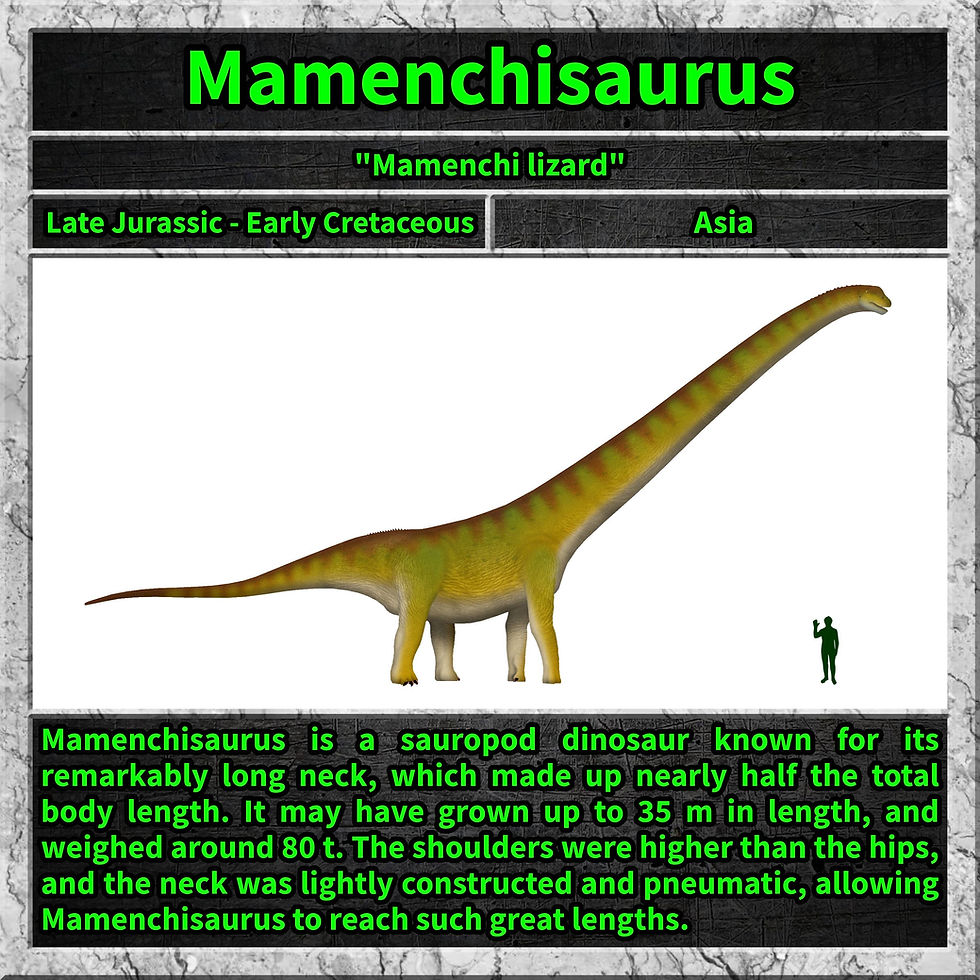Mamenchisaurus
- unexpecteddinolesson
- Mar 16
- 3 min read
MEANING: Mamenchi lizard
PERIOD: Late Jurassic - Early Cretaceous
CONTINENT: Asia
Mamenchisaurus is a sauropod dinosaur known for its remarkably long neck, which made up nearly half the total body length. It may have grown up to 35 m in length, and weighed around 80 t. The shoulders were higher than the hips, and the neck was lightly constructed and pneumatic, allowing Mamenchisaurus to reach such great lengths.

Mamenchisaurus is from the Jurassic and Cretaceous. The Jurassic is a geologic period that spanned from the end of the Triassic, 201 million y ears ago, to the beginning of the Cretaceous, 145 million years ago. It is the middle period of the Mesozoic Era. The start of the Jurassic was marked by the major Triassic-Jurassic extinction event. The end, however, has no clear boundary with the Cretaceous. By the beginning of the Jurassic, Pangea had begun rifting into two landmasses: Laurasia and Gondwana, and the climate was warm with no ice caps. Life on land was dominated by dinosaurs, and the first birds appeared, evolving from a branch of theropods. The oceans were inhabited by marine reptiles, while pterosaurs were the dominant flying vertebrates.
The Cretaceous is a geological period that lasted from about 145 to 66 million years ago. It is the third and final period of the Mesozoic Era, as well as the longest. At around 79 million years, it is the longest geological period of the entire Phanerozoic. The name is derived from the Latin creta, "chalk", which is abundant in the latter half of the period.
The Cretaceous was a period with a relatively warm climate, resulting in high eustatic sea levels that created numerous shallow inland seas. These oceans and seas were populated with now-extinct flora and fauna, while dinosaurs continued to dominate on land. The world was ice free, and forests extended to the poles. During this time, new groups of mammals and birds appeared. During the Early Cretaceous, flowering plants appeared and began to rapidly diversify, becoming the dominant group of plants across the Earth by the end of the Cretaceous, coincident with the decline and extinction of previously widespread gymnosperm groups.
The Cretaceous (along with the Mesozoic) ended with the Cretaceous–Paleogene extinction event, a large mass extinction in which many groups, including non-avian dinosaurs, pterosaurs, and large marine reptiles, died out. The end of the Cretaceous is defined by the abrupt Cretaceous–Paleogene boundary (K–Pg boundary), a geologic signature associated with the mass extinction that lies between the Mesozoic and Cenozoic Eras.
Mamenchisaurus is a sauropod. Sauropods are saurischian dinosaurs that had very long necks, long tails, small heads (relative to the rest of their body), and four thick, pillar-like legs. They are notable for the enormous sizes attained by some species, and the group includes the largest animals to have ever lived on land. Well-known genera include Brachiosaurus, Diplodocus, Apatosaurus and Brontosaurus.
The oldest known unequivocal sauropod dinosaurs are known from the Early Jurassic, and by the Late Jurassic (150 million years ago), sauropods had become widespread. By the Late Cretaceous, one group of sauropods, the titanosaurs, had replaced all others and had a near-global distribution. This group included the largest animals ever to walk the earth. Estimates vary, but the largest titanosaurs are estimated at upward of around 40 m, and weighing 100 t, or possibly even more.
As with all other non-avian dinosaurs alive at the time, the titanosaurs died out in the Cretaceous–Paleogene extinction event. Fossilized remains of sauropods have been found on every continent, including Antarctica.

